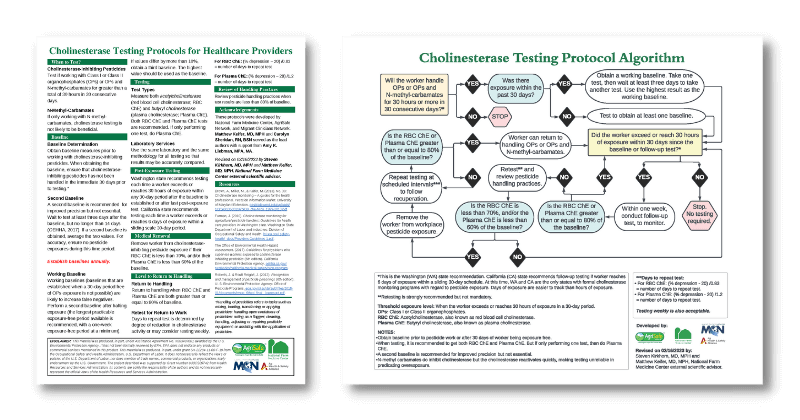This resource (in English and Spanish) gives a basic overview of what breast cancer is and some of the general terms used to describe breast cancer.
- WhatIsBreastCancerEnglish_0.doc (96 KB)
- QueEsElCancerDeSeno_0.pdf (887.6 KB)
This resource includes some facts about skin cancer including risk factors and the signs and symptoms of skin cancer.
- SkinCancerFactsEnglish_0.doc (45.5 KB)
The information that follows is an overview of this type of cancer. It is based on the more detailed information in American Cancer Society's document, Cervical Cancer. This document and other information can be obtained by calling 1-800-227-2345 or visiting our Web site at www.cancer.org.
- CervicalCancerEnglish_0.pdf (125.74 KB)
- CervicalCancerSpanish_0.pdf (171.83 KB)
Patient education handout in English and Spanish on colorectal cancer from the American Cancer Society.
- ColorectalCancerEnglish_0.pdf (358.53 KB)
- ColorectalCancerSpanish_0.pdf (185.35 KB)
copy deeplink Cholinesterase (ChE) Testing Protocols and Algorithm for Healthcare Providers
Cholinesterase (ChE) Testing Protocols and Algorithm for Healthcare Providers
These Cholinesterase (ChE) clinical tools provide a concise and simple format to guide clinicians in monitoring the ChE levels for patients working with Class I and Class II organophosphates (OP) or OP and N-methyl-carbamates.
copy deeplink The Health Center Recruitment and Retention Review Tool
The Health Center Recruitment and Retention Review ToolThe Health Center Recruitment and Retention Review Tool is designed to support on-going recruitment and retention of qualified clinical staff at health centers funded by the Bureau of Primary Health Care (BPHC) under section 330 of the Public Health Service Act as amended by the Health Centers Consolidation Act of 1996.
- RRreviewtool_Revised52412.pdf (826 KB)
copy deeplink 2011 Year In Review | Migrant Clinicians Network
2011 Year In Review | Migrant Clinicians Network2-page highlight of MCN's services and programs in action during 2011 available in English and Spanish.
MCN's Year in Review 2011 is also available as the Prezi interactive presentation.
copy deeplink Americans’ Views on Illegal Immigrants THE NEW YORK TIMES/CBS NEWS POLL
Americans’ Views on Illegal Immigrants THE NEW YORK TIMES/CBS NEWS POLLSummary of the June 2012 article from the New York Times on American attitudes toward immigration.
An April 2012 article from the Arizona Republic citing poll data on attitudes toward immigration in the state.
copy deeplink Establishing an Integrated Care Practice in a Community Health Center
Establishing an Integrated Care Practice in a Community Health CenterThis article describes an excellent integrated behavioral health program at a Federally Funded Health Center. The full abstract from the article is as follows: In a progressively complex and fragmented health care system and in response to the need to provide whole-person, quality care to greater numbers of patients than ever before, primary care practices throughout the United States have turned their attention and efforts to integrating behavioral health into their standard service-delivery models. With few resources and little guidance, systems struggle to gather the support required to establish effective integrated programs. Based on first-hand experience, we describe a working integrated primary care model, currently utilized in a large community health center system in Colorado, that encompasses universal screening, consultation, psychotherapy, and psychological testing. With appreciation for the way an organization’s unique circumstances inform the best approach for that particular organization, we highlight the clinical level and system-level variables that we consider necessary for successful practice development and address how our behavioral health program operates despite funding limitations. We conclude that organizations that aim for integrated primary care must mobilize leadership to implement systemic changes while making difficult decisions about program development, financing, staffing, and interagency relationships.